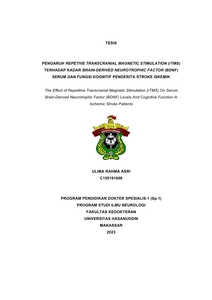Asri, Ulima Rahma (2023) PENGARUH REPETITIVE TRANSCRANIAL MAGNETIC STIMULATION (rTMS) TERHADAP KADAR BRAIN-DERIVED NEUROTROPHIC FACTOR (BDNF) SERUM DAN FUNGSI KOGNITIF PENDERITA STROKE ISKEMIK = Transcranial Magnetic Stimulation Can Improve Cognitive Function and Brain-Derived Neurotrophic Peptide Levels in Post- Ischemic Stroke Patients. Skripsi thesis, Universitas Hasanuddin.
![[thumbnail of Cover]](/47781/1.hassmallThumbnailVersion/C155191008_tesis_28-02-2024%20Cover1.jpg)

C155191008_tesis_28-02-2024 Cover1.jpg
Download (275kB) | Preview
C155191008_tesis_28-02-2024 bab1-2.pdf
Download (4MB)
C155191008_tesis_28-02-2024 Dapus.pdf
Download (1MB)
C155191008_tesis_28-02-2024.pdf
Restricted to Repository staff only until 2 November 2026.
Download (7MB)
Abstract (Abstrak)
Stroke can cause a significant burden of morbidity, including
complications of impaired cognitive function. The problem being investigated is hypothesized to be related to brain-derived neurotrophic factor (BDNF), which can be increased by repetitive transcranial magnetic stimulation (rTMS). Purpose(s): To evaluate the effect of Repetitive Transcranial Magnetic Stimulation (rTMS) on serum BDNF levels and cognitive function in ischemic stroke patients. Methods: A pre-test post-test control group, experimental study design, was applied to research
conducted at Dr Wahidin Sudirohusodo Makassar and network hospitals in June 2023 until the sample size was met. All ischemic stroke patients who experienced
impaired memory function were divided into control (medicamentous, n=10) and
treatment (medicamentous + rTMS, n=11). Both at baseline and 14 days following
therapy, their BDNF levels and MoCA-INA scores were assessed. ELISA
examination is used to measure BDNF levels. The dependent T-test was used to
analyze changes in MoCA-INA and BDNF scores in each group. Results: In the
treatment group, the median MoCA INA score (26.00 (18.00-28.00) vs. 16.00
(13.00-21.00; p=0.001)) and BDNF levels (1.66 (0.78-3.59) vs. 1.55 (0.01-2.76);
p=0.002) increased in two weeks. In contrast, the MoCA-INA score and BDNF
levels in the control group did not show a statistically significant difference over a
two-week period. MoCA-INA scores and BDNF levels in the treatment group
showed a significant and favorable correlation, but not in the control group.
Conclusion: rTMS can improve patients' cognitive function after ischemic stroke
by improving BDNF levels.
| Item Type: | Thesis (Skripsi) |
|---|---|
| Uncontrolled Keywords: | Brain-derived neurotrophic factor, cognitive function, ischaemic stroke, repetitive transcranial magnetic stimulation |
| Subjects: | R Medicine > R Medicine (General) |
| Divisions (Program Studi): | Fakultas Ekonomi > Ilmu Akuntasi |
| Depositing User: | Nasyir Nompo |
| Date Deposited: | 23 Jul 2025 07:31 |
| Last Modified: | 23 Jul 2025 07:31 |
| URI: | http://repository.unhas.ac.id:443/id/eprint/47781 |


